UN DESA produces estimates of the number of international migrants globally, which are based on data provided by States.
The United Nations Recommendations on Statistics of International Migration defines an “international migrant” as any person who has changed his or her country of usual residence, distinguishing between “short-term migrants” (those who have changed their countries of usual residence for at least three months, but less than one year) and “long-term migrants” (those who have done so for at least one year). However, not all countries use this definition in practice. Some countries use different criteria to identify international migrants by, for example, applying different minimum durations of residence. Differences in concepts and definitions, as well as data collection methodologies between countries, hinder full comparability of national statistics on international migrants.
Overall, the estimated number of international migrants has increased over the past five decades. The total estimated 272 million people living in a country other than their countries of birth in 2019 was 119 million more than in 1990 (when it was 153 million), and over three times the estimated number in 1970 (84 million). While the proportion of international migrants globally has also increased over this period, it is evident that the vast majority of people continue to live in the countries in which they were born.
International migrants, 1970–2019
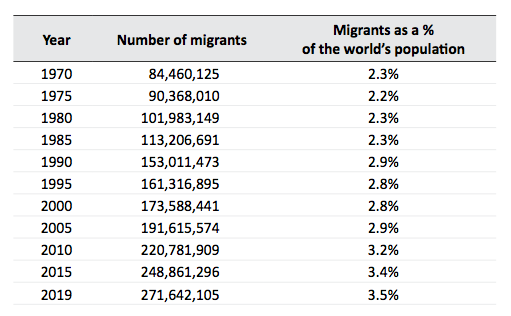
In 2019, most international migrants (around 74%) were of working age (20 to 64 years of age), with a slight decrease in migrants younger than 20 years old from 2000 to 2019 (from 16.4% to 14%), and a constant share (around 12%) of international migrants 65 years of age and older since 2000.
The international migrant population globally has increased in size but remained relatively stable as a proportion of the world’s population
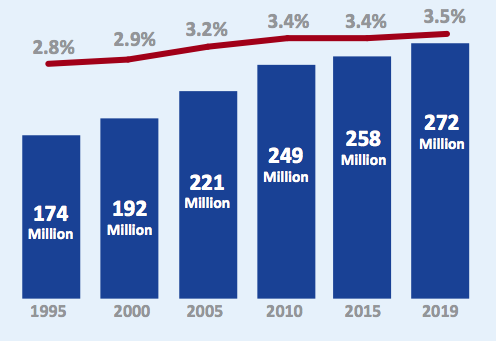
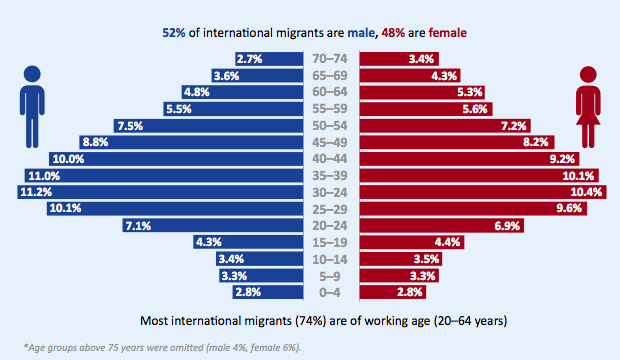
In 2019, Europe and Asia each hosted around 82 million and 84 million international migrants, respectively – comprising 61% of the total global international migrant stock combined. These regions were followed by North America, with almost 59 million international migrants in 2019 or 22 per cent of the global migrant stock, Africa at 10%, Latin America and the Caribbean at 4%, and Oceania at 3%. When compared with the size of the population in each region, shares of international migrants in 2019 were highest in Oceania, North America and Europe, where international migrants represented, respectively, 21%, 16% and 11% of the total population. In comparison, the share of international migrants is relatively small in Asia and Africa (1.8% and 2%, respectively) and Latin America and the Caribbean (1.8%). However, Asia experienced the most remarkable growth from 2000 to 2019, at 69% (around 34 million people in absolute terms). Europe experienced the second largest growth during this period, with an increase of 25 million international migrants, followed by an increase of 18 million international migrants in North America and 11 million in Africa.
International migrants, by major region of residence, 2005 to 2019 (millions)
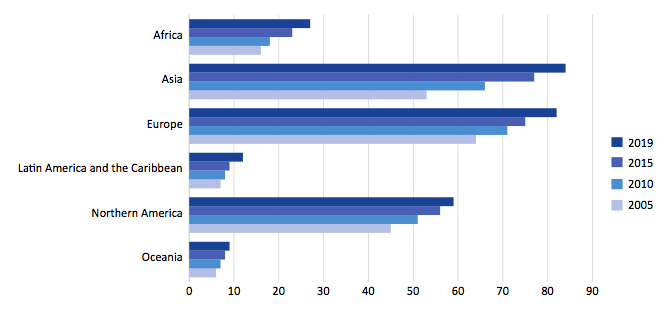
The increase in international migration in some regions over time has had an impact on population change. Figure below shows the proportional population change for each of the world’s six regions from 2009 to 2019. While Europe has traditionally been one of the major destination regions for international migrants, it has had the slowest rate of proportional population change over this period, at slightly over 1%. However, the rate would arguably be much lower without international migrants who have mitigated decreasing populations in some European countries due, for example, to declining birth rates. By comparison, Africa underwent the most significant change, with its population growing by nearly 30% over this period, due to high fertility rates and increasing lifespans. This growth has nevertheless been softened by emigration from Africa to other regions (namely Europe and Asia).
Proportional population change by region, 2009–2019
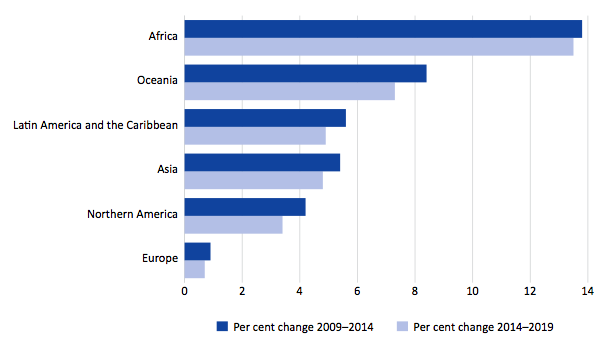
While population growth over the decade may be most pronounced for Africa, in 2019 more than half the world’s total population resided in just one region: Asia (4.6 billion people). From 2009 to 2019, the population in Asia grew by nearly 440 million (from 4.16 billion to 4.6 billion), compared with just under 300 million in Africa (from 1.01 billion to 1.31 billion). Five of the world’s top 10 most populous countries are in Asia (China, India, Indonesia, Pakistan and Bangladesh).
The United States of America has been the main country of destination for international migrants since 1970.15 Since then, the number of foreign-born people residing in the country has more than quadrupled – from less than 12 million in 1970, to close to 51 million in 2019. Germany, the second top destination for migrants, has also observed an increase over the years, from 8.9 million in 2000 to 13.1 million in 2019.
More than 40% of all international migrants worldwide in 2019 (112 million) were born in Asia, primarily originating from India (the largest country of origin), China, and South Asian countries such as Bangladesh, Pakistan and Afghanistan. Mexico was the second largest country of origin, and the Russian Federation was fourth. Several other European countries have sizeable populations of emigrants, including Ukraine, Poland, the United Kingdom and Germany.
Top 20 destinations and origins of international migrants in 2019 (millions)
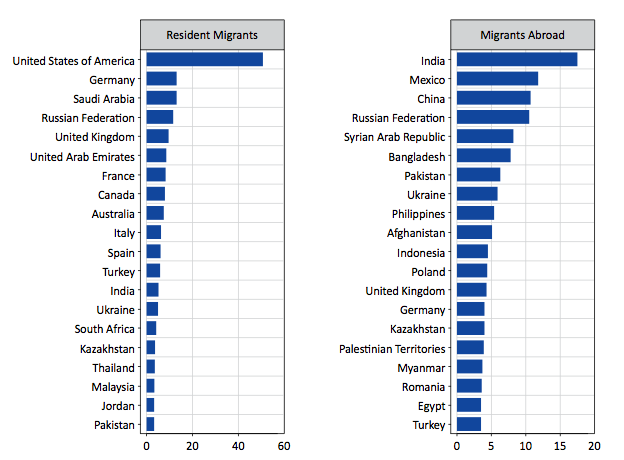
In regard to the distribution of international migrants by countries’ income group, nearly two thirds of international migrants resided in high-income countries in 2019 – around 176 million. This compares with 82 million foreign-born who resided in middle-income countries (about one third of the total migrant stock) and 13 million in low-income countries in the same year.
While international migrants may tend to gravitate toward high-income countries, their origins globally can be diverse. Some origin countries have high proportions of their nationals living abroad for economic, political, security, trade or cultural reasons that may be contemporary or historical in nature. For example, the Syrian Arab Republic has a higher rate of emigration than most other countries due to displacement caused by long-term conflict. Figure below highlights countries with high proportions of emigrants in 2019. Importantly, the emigration proportion of a country represents an accumulation of migration (and displacement) over time, sometimes many decades. Of note is the geographic diversity of the countries in figure below (countries from all regions except Northern America are included) as well as the high number of countries from Latin America and the Caribbean (10 of the 20 countries).
Top 20 countries of emigration in 2019 (proportion)
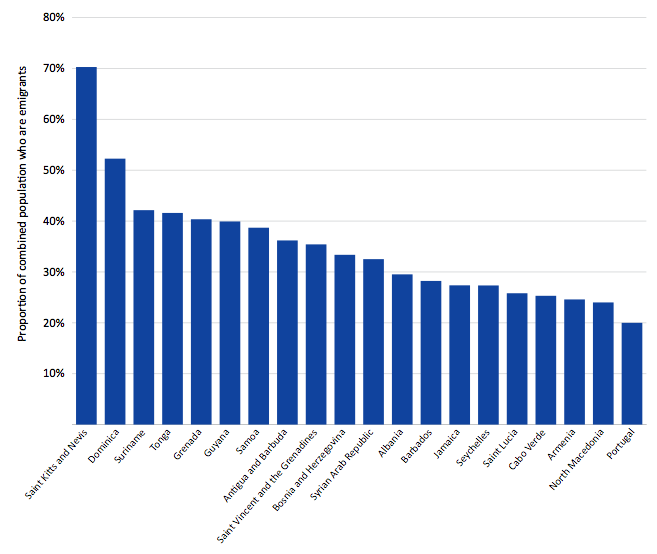
UN DESA estimates of foreign-born populations do not reflect immigration status or policy categories (such as students, highly skilled migrants, or refugees). Capturing such attributes is inherently difficult for several key reasons. First, a person’s immigration status can be fluid and change quickly, arising from circumstances and legal/policy settings. For example, many international migrants who may be described as ‘‘undocumented” or “irregular” enter countries on valid visas and then stay in contravention of one or more visa conditions. In fact, there are many paths to irregularity, such as crossing borders without authorisation, unlawfully overstaying a visa period, working in contravention of visa conditions, being born into irregularity, or remaining after a negative decision on an asylum application has been made.
Second, countries have different immigration policy settings and different ways of collecting data on migrants, which makes it difficult to establish a harmonised approach to capturing irregular migrant stocks globally. The pace of change in the migration policy arena also poses an extra dimension of complexity, as people may slip into and out of “irregularity”. Notably, there have been very few global estimates of the number of irregular migrants because of this complexity. However, this has not prevented some organisations from coming up with inflated and incorrect global estimates—see text box below on “what not to do”.
Third, as noted in the text box earlier on the chapter on “defining migration, migrant and other key terms”, there necessarily exist different definitions, depending on the circumstances in which they are applied. In some legal/policy situations, as well as in general discussions, for example, a “migrant” can include a person who has never migrated.
SOURCE: UN DESA, IOM
IMAGE CREDIT: Wikimedia Commons

